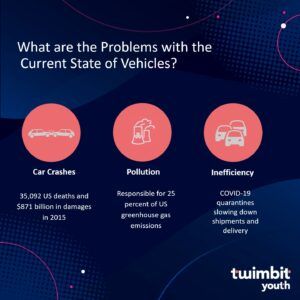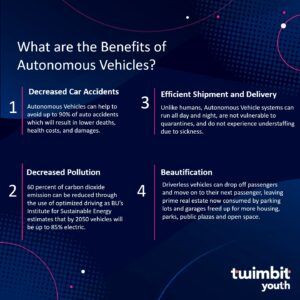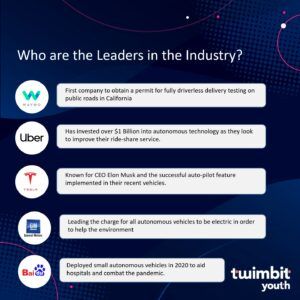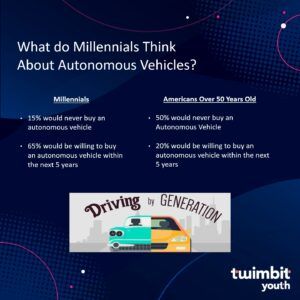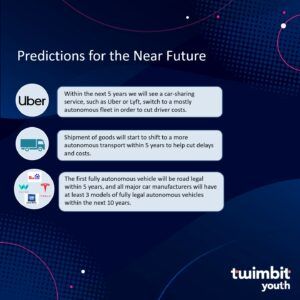COVID-19 has forced many changes to the normalcy of society. The disease has run rampant throughout the world and especially in the United States. Some changes are more noticeable, such as wearing masks or the increase in food delivery services like DoorDash.
One effect of COVID-19 is that it has sped up the necessity for Autonomous Vehicles. Autonomous vehicles are necessary for our future to maximize business efficiency, preserve a clean earth, and keep all drivers on the road safe.
Problems with Current State of Vehicles
The problems with the state of vehicles today are the number of car-related deaths, the amount of pollution gas-powered cars emit, and the inefficiency they cause in many aspects of the business. The National Highway Traffic Safety Administration reported that 35,092 people died in 2015 in automobile accidents in the United States.
In addition to the human toll, car crashes greatly burden the U.S. economy, costing an estimated USD 871 billion per year. According to the EPA, motor vehicles collectively cause 75 percent of carbon monoxide pollution in the U.S. In total, motorized vehicles are the cause of almost a third of the United States greenhouse gases. And finally, with COVID-19 continually pausing the shipment of goods, this has highlighted the human factor of transporting goods as a fragile link in the national supply chain for goods.
Benefits of Autonomous Vehicles
Road Safety – Studies from the Boston Consulting Group suggest that autonomous vehicles will help to significantly reduce car crashes and drastically lower the quantity of car-related deaths. A number of other sources also suggest that autonomous vehicles can help to avoid up to 90% of auto accidents which will result in lower deaths, health costs, and damages.
Decreased Pollution – With autonomous vehicles, the amount of carbon emissions will also decrease as constantly on the road. Some studies found that as much as 60 percent of carbon dioxide emission can be reduced through optimized driving as BU’s Institute for Sustainable Energy estimates that by 2050, vehicles will be up to 85% electric.
Efficient Shipment – The effects of COVID-19 have exposed a multitude of uses for autonomous vehicles that would benefit the overall efficiency of society and business. Unlike humans, Autonomous Vehicle systems can run all day and night, are not vulnerable to 14-day quarantines and do not experience understaffing due to sickness. In times of emergencies, the ability to efficiently and reliably transport goods throughout the supply chain is more important than ever before.
Beautification– Autonomous Vehicles also have social effects in the positive beautification impact they will have on major cities. For example, because driverless vehicles can drop off passengers and move on to their next passenger, prime real estate now in use by parking lots and garages could make way for more housing, parks, open space and public plazas, planners say. Additionally, autonomous vehicles have the capacity to be more quickly accessible than current public transportation or ride-sharing apps such as Uber or Lyft.
Leaders in Autonomous Vehicles
In the race to get autonomous technology out into the world, a number of companies lead the charge. The current front runner is Waymo, a subsidiary of Google parent company Alphabet. Waymo began testing autonomous vehicles in 2009 and was the first company to obtain a permit for fully driverless delivery testing on public roads in California.
Other leaders in the industry include Uber, General Motors, Tesla, and Baidu. Baidu, a China-based technology company, successfully grew in 2020 as the company deployed autonomous vehicles to combat the pandemic. Vice president Zhenyu Li stated that “having been through the pandemic and supported the front line, we realize ‘automation’ and ‘intelligence’ are the best solutions for humans to respond to large-scale emergencies” (Baidu). As technological capabilities limited previous unmanned vehicles, the pandemic awakened a need for autonomous vehicles to improve safety, deliver supplies, and advance new infrastructures.
Challenges of Autonomous Vehicles
Jobs – The adoption of Autonomous vehicles will also face some challenges. One potential problem with autonomous vehicles is that they may take away jobs. Jobs currently held by human workers such as taxi, public transit, or Uber drivers could face replacement as a result of autonomous vehicles operating on their own. Autonomous vehicles have the potential to displace human drivers if and when they are in use for commercial trucking fleets, taxi services, and school and transit bus services. Other potential challenges for autonomous vehicles include technology, liability, and consumer demand.
Sensors – Autonomous cars use sensor technology to recognize the environment around them. These sensors take the data they observe to the car’s computer to help make decisions about how to drive safest. Bad weather, intense traffic, and vandalized road signs can all impact the accuracy of the car sensors. Radar, the sensor Tesla uses, is designed to be less susceptible to adverse weather conditions, but ensuring that the sensors can detect all hazards within the required level of certainty for them to be safe is still a challenge.
Liability – While companies hope for their technology to be perfect, the reality is that there will still be car crashes with autonomous vehicles. The question then switches to who is liable; the car or the driver? Although legislation is in discussion, nationwide standards and regulations do not currently exist. In order for autonomous vehicles to be adopted, standards and regulations must be in place that will make the manufacturer, the consumer, and insurance companies comfortable with the vehicles being on the open road.
Consumer Demand– Even with the potential legislation, there are people that are rightfully concerned with the idea of robots on the road. Many people feel uncomfortable knowing that they are driving alongside a vehicle that is not under the control of a human being. Current numbers for Americans in favor of autonomous vehicles fluctuate anywhere from 30 to 50% depending on the source. This number will have to be much higher if autonomous vehicles are to be universally adopted.
Infrastructure – Urban planners will have the task of redesigning cities and roads that are more accessible for autonomous vehicles. These upgrades will be very costly and could include large numbers of electric charging stations, roadside drop off lanes, increased road maintenance, and repurposing parking garages. Cities will need an infrastructure specifically designed for autonomous vehicles to keep them efficient and safe.
Millennial Mindset
While the overall population is still on the fence about autonomous vehicles, the support increases dramatically the younger the generation. According to a poll done by TheDrive, 50% of people over 50 said they would never be willing to own an autonomous car (Brandt). On the other hand, Millennials had the lowest rate, with only 15% saying they would never be willing to buy an autonomous car. Additionally, over 65% of millennials would be willing to buy an autonomous vehicle within the next five years, which is significantly higher than any other age group. Clearly, millennials are ready and the most receptive to the coming change in the automobile industry.
The Near Future
The future of autonomous vehicles is exciting. Autonomous vehicles are the future of society. There are too many benefits that autonomous vehicles provide; thus, it deserves a try to ramp up their implementation into society. We have already seen Tesla successfully implement an auto-pilot feature in their latest cars, showing that it is a matter of time until the next breakthrough occurs. Within the next five years, I predict that we will see a car-sharing service, such as Uber or Lyft, switch to a mostly autonomous fleet. This prediction is because these companies are still operating at a loss and will look to lower costs by cutting out the driver expense.
Similarly, I predict that the shipment of goods will start to shift to a more autonomous transport within five years to help cut delays and costs. Finally, I predict that the first fully autonomous vehicle will be road legal within five years, and all major car manufacturers will have at least two models of fully legal autonomous vehicles within the next ten years. With autonomous vehicles, the United States and the world will see incredible rates of efficiency, safety, and health that are necessary for the ever-changing 21st century.
Key Takeaways
Why We Need Change – Massive physical, economic, and environmental damages occur every year as a result of the current state of cars.
Benefits – Autonomous vehicles will save lives, money and lead to cleaner cities and environments.
Leaders – Waymo, Tesla, and others are in fierce competition to produce the first autonomous vehicle.
Challenges – Companies must figure out a way to perfect sensors and work with the government to ensure fair legislation in order for autonomous vehicles to a desire globally.
To view Youth Summit- America’s Chapter click here
Bibliography
“5 Effects of the Adoption of Autonomous Vehicles.” Ohio University, 11 Feb. 2020
Baidu. “How Coronavirus Is Accelerating a Future with Autonomous Vehicles.” MIT Technology Review, MIT Technology Review, 4 July 2020
Brandt, Eric. “Millennials Are Ready for Self-Driving Cars.” The Drive, The Drive, 24 Oct. 2017,
www.thedrive.com/article/15406/millennials-are-ready-for-self-driving-cars
Britt, Hugo. “Meet the 6 Frontrunners in the Self-Driving Car Race.” Thomasnet® – Product Sourcing and Supplier Discovery Platform – Find North American Manufacturers, Suppliers and Industrial Companies, Thomasnet, Jan. 2020
Gaddam, Dr. Srikanth. “The Future of Autonomous Driving: Impact on Business, Workforce and Societies.” The Ritz Herald, Oct. 2020, ritzherald.com/the-future-of-autonomous-driving-impact-on-business-workforce-and-societies
Hatch, Jennie, and John Helveston. “Important Announcement.” Institute for Sustainable Energy Will Autonomous Vehicles Be Electric Comments, 1 Jan. 1968
“Is the Future Now? Autonomous Vehicle Technology and Consumer Demand.” Resources for the Future, Sept. 2017
LLP, Foley & Lardner. “The Impact of COVID-19 on Adoption of Autonomous Vehicle Technology: Foley & Lardner LLP.” Blogs | Dashboard Insights | Foley & Lardner LLP, Foley & Lardner LLP, 19 Aug. 2020
McDermid, John. “Autonomous Cars: Five Reasons They Still Aren’t on Our Roads.” The Conversation, 23 Nov. 2020
Shaver, Katherine. “City Planners Eye Self-Driving Vehicles to Correct Mistakes of the 20th-Century Auto.” The Washington Post, WP Company, 21 July 2019
Staff, RBR, and RBR Staff. “Consumer Acceptance of Self-Driving Cars Soars, Study Says.” Robotics Business Review, 9 May 2019
Stricker, Klaus, et al. “Electric and Autonomous Vehicles: The Future Is Now.” Bain, 29 Oct. 2020



